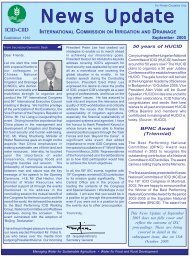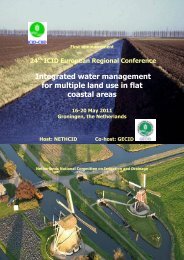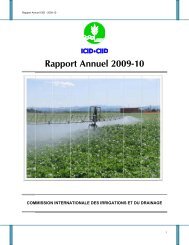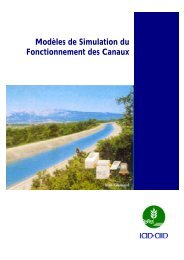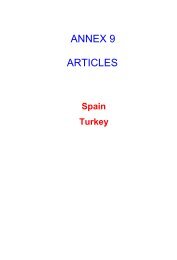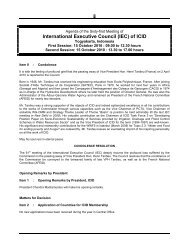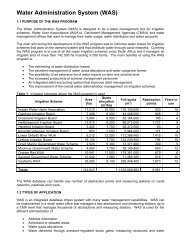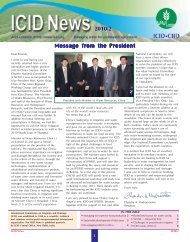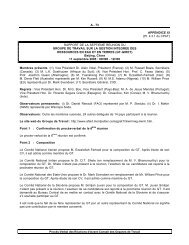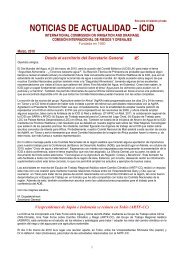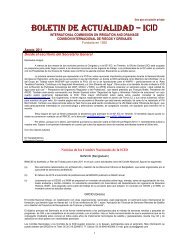Korea, Republic of
Korea, Republic of
Korea, Republic of
You also want an ePaper? Increase the reach of your titles
YUMPU automatically turns print PDFs into web optimized ePapers that Google loves.
<strong>Korea</strong>, <strong>Republic</strong> <strong>of</strong>1. PHYSIOGRAPHYThe <strong>Republic</strong> <strong>of</strong> <strong>Korea</strong> is a peninsula located between the People's <strong>Republic</strong> <strong>of</strong> China and Japan. It liesbetween the latitudes 33° 6' N and 38° 31' N and has many islands along the west and south coastlines. Thetotal territorial area <strong>of</strong> <strong>Korea</strong> is 99,373 km2, while 19,235 km2 or 19.4 percent <strong>of</strong> the total area are arable.Forest area is 64,410 km2 or 64.8 percent <strong>of</strong> the total area. Rivers, roads, residential area, industrial sites, orothers occupy the rest.<strong>Korea</strong> is a mountainous country and high mountains are located along the eastern part <strong>of</strong> the peninsula.Most plains and hilly areas are scattered in the western and southern parts <strong>of</strong> the country. Therefore,agriculture is mainly developed in the south-western part <strong>of</strong> the country. Major rivers flow into the YellowSea in the west and the South Sea in the south.Divides <strong>of</strong> watersheds <strong>of</strong> the major rivers are in the eastern part <strong>of</strong> the peninsula. So major rivers flow longdistance from east to west or from north to south through low valleys and plains and become good irrigationwater sources. The eastern coast <strong>of</strong> the <strong>Korea</strong>n Peninsula has steep slopes, simple shorelines and deep waterdepth. But there are many islands and irregular shorelines in the western and southern coasts. Tidal range <strong>of</strong>the western coast is very high and tidal flats are well developed. Many tidal land reclamation works wereimplemented in the past and a good potential for tidal land reclamation widely prevails.2. CLIMATE AND RAINFALL<strong>Korea</strong> lies within the temperate zone between the People's <strong>Republic</strong> <strong>of</strong> China and the Pacific Ocean. Theclimate is mainly dependent on the Pacific Ocean air masses during the summer months and on thecontinental air masses during the winter months. <strong>Korea</strong> has four distinct seasons. Summer is hot and humid,while winter is cold and dry. The climates <strong>of</strong> spring and autumn are moderate and dry. A long drought fromwinter to spring or a severe spring drought <strong>of</strong>ten threatens transplanting <strong>of</strong> rice which is carried out in Mayor June.The monthly average temperature is higher than 20° C during the summer months from June to Septemberand it falls below freezing point during the winter months from December to February. The highest monthlytemperature occurs in August and the lowest in January. The highest temperature in <strong>Korea</strong> was recorded at40° C in August and the lowest temperature –28.5° C in January. Temperature also varies with the location,showing high in the southern part and low in the northern part. The southeast wind prevails in summer andthe northwest wind in winter.Annual average precipitation is 1,274 mm and the annual precipitation varies greatly year by year rangingfrom 754 mm to 1,683 mm. More than two third <strong>of</strong> the annual precipitation occurs during the summermonths from June to September.Typhoons originating from the Pacific Ocean pass the peninsula mainly in August and September. Gusts andstorms accompanied by typhoons sometimes cause severe damages to crops or other properties.3. POPULATION AND SIZE OF HOLDINGSThe population <strong>of</strong> <strong>Korea</strong> was 24,952 thousand in 1960, 31,466 thousand in 1970, 37,436 thousand in 1980,43,411 thousand in 1990, 44,551 thousand in 1995 and 45,991 thousand in 1997. <strong>Korea</strong> is one <strong>of</strong> the mostpopulated countries showing the population density <strong>of</strong> 463 persons/km2 in 1997.ICID – Irrigation & Drainage in the World – A Global Review 1
The population engaged in agriculture in 1997 was 4,468 thousand persons or 9.7 percent <strong>of</strong> the totalpopulation. Due to the fast industrialization and rapid expansion <strong>of</strong> urban areas, the percentage <strong>of</strong> populationin the agricultural sector has sharply decreased during last several decades.The average size <strong>of</strong> farm holding has been steadily increased from 0.97 ha in 1977 to 1.366 ha in 1997mainly due to decrease in farm households and with the Government’s continuous efforts.4. LAND RESOURCES<strong>Korea</strong> has 99,373 km2 <strong>of</strong> total land area in 1997 out <strong>of</strong> which the cultivated land covers 19,235 km2; paddyfields (11,629 km2) and upland (7,606 km2). The remaining 80,138 km2 is occupied by mountainous areas(64,413 km2) and other uses (15,725 km2).The soils <strong>of</strong> <strong>Korea</strong> have been generally divided into soil groups such as low humic gley, alluvial, red-yellowpodzolic, regosols, lithosols, reddish brown lateritic, acid brown forest, planosols, saline alluvial, acidsulphate and organic soils. Most <strong>of</strong> the irrigation practices have taken place on the low humic gley andalluvial soils in the paddy field areas.Humic gley and alluvial soils are spread in the coastal plains, flood plains, inland alluvial plains and localvalleys. These soils are medium or fine textured and are poorly or imperfectly drained and have relativelyhigh or medium productivity. They are found mainly on the western and southern coastal plains and in thelower Nakdong, Han, Yongsan and Keum river basins. Most <strong>of</strong> the lands are well suited to paddy rice andare intensively used for that crop.Red-yellow podzolic soils, regosols and lithosols are formed on rolling areas, in middle or strongly dissectedpart, denuded areas <strong>of</strong> older paddy plains and hilly and mountainous lands underlain by residual materialssuch as granites, gneisses, andesites, porphytries, shales and conglomerates. Topography is rolling withsome undulating and more steeply sloping areas. Dominant slopes range from 7 to 60 percent. Interfingereddendritic patterns <strong>of</strong> narrow valleys are found. These valleys are U-shaped and include nearly levelled orgently sloping land along the valley floor. These soils are distributed mostly on the western and southernparts <strong>of</strong> the country. The soils were originally under natural vegetations <strong>of</strong> pine trees, acacias, shrubs andgrasses. Presently some <strong>of</strong> these soils are for production <strong>of</strong> upland crops, such as barley, wheat, millet, sweetpotato, soy bean, corn, sesame, tobacco, red pepper and other vegetables. Where water is available forirrigation, paddy rice is principal crop. The high areas that cannot be irrigated are used for the production <strong>of</strong>general upland crop, forage crops and fruits.5. WATER RESOURCESSurface waterThe average annual precipitation in <strong>Korea</strong> is 1,274 mm and it indicates 126.7 billion m3 <strong>of</strong> water in volume.The average annual run<strong>of</strong>f is 69.7 billion m3 (55 percent) and the annual volume lost by evaporation orothers is about 57 billion m3 (45 percent). More than two-third <strong>of</strong> the annual run<strong>of</strong>f occurs during the floodseason from June to September and so that a great amount <strong>of</strong> the water becomes unusable. Total availablesurface and ground water is estimated at 47.2 billion m3 which includes 23 billion m3 <strong>of</strong> river flows duringthe non-flood season, 10.8 billion m3 <strong>of</strong> stored water in multipurpose dams and agricultural reservoirs and13.4 billion m3 <strong>of</strong> ground water. Yearly water use amounts about 30.1 billion m3; 14.9 billion m3 (50percent) for irrigation, 2.6 billion m3 (9 percent) for industrial water, 6.2 billion m3 (20 percent) formunicipal water and 6.4 billion m3 (21 percent) for instream flow augmentation. Half <strong>of</strong> the total water usecomes from agricultural use.Out <strong>of</strong> 14.9 billion m3 <strong>of</strong> irrigation water, 9.4 billion m3 is supplied by about 18 thousand agriculturalICID – Irrigation & Drainage in the World – A Global Review 2
eservoirs, 2.7 billion m3 by pumping stations, 1.9 billion m3 by headworks and 0.9 billion m3 bytube-wells or others.Ground waterFrom considerations <strong>of</strong> geologic condition, the <strong>Korea</strong>n Peninsula is comprised <strong>of</strong> crystalline sedimentaryrocks and a few kinds <strong>of</strong> bed rocks such as granite and granite-gneisses, which occupy about 70 percent <strong>of</strong>total area <strong>of</strong> the country. And the remaining area 27,370 km2 is covered with alluvial deposits.Except some regions, the quantities <strong>of</strong> the ground-water storage in the bed rocks are not sufficient forirrigation. But relatively large quantities <strong>of</strong> the ground water are extractable from the basalt areas <strong>of</strong>CheJu-Island (total area <strong>of</strong> 1,280 km2), from limestone areas <strong>of</strong> Kangwon-Do, and from the tertiary strata <strong>of</strong>Phohang-Woolsan areas in the eastern part <strong>of</strong> the country.In addition, alluvial deposits, such as coastal plains, flood plains <strong>of</strong> large streams, intermountain plains,plains between valleys, deltas, etc., may be classified as significant aquifers. But their thickness does notexceed several meters except the deposits in the lower part <strong>of</strong> the Han River and the Keum River.Out <strong>of</strong> a total potential groundwater storage <strong>of</strong> 1,324 billion m3, the available amount <strong>of</strong> ground water isevaluated to be 16.8 billion m3. In <strong>Korea</strong>, groundwater is not a major source <strong>of</strong> irrigation water and it coversless than five percent <strong>of</strong> irrigated land. Groundwater <strong>of</strong>ten used for supplementary irrigation water duringdrought periods.Irrigation facilities, including 3,853 infiltration galleries and 16,001 tube wells to irrigate 20,509 ha and30,586 ha respectively, were installed by the end <strong>of</strong> 1997.6. BRIEF HISTORY OF IRRIGATION AND DRAINAGEIt was known that rice culture in the <strong>Korea</strong>n Peninsula began in the fourth or third century B.C. Riceconsumes much water in comparison with other crops and generally requires irrigation. Therefore, irrigationin <strong>Korea</strong> was mainly developed for rice culture and rice irrigation dated back to the first century A.D.From the beginning, most irrigation water was obtained from rivers and streams by constructing smallreservoirs, diversion weirs or feeder canals. The Pyokkol reservoir, the oldest one remained in <strong>Korea</strong>, wasconstructed in 330 A.D. The reservoir had a dam with four kilometer long and could irrigate about 10,000ha.Many irrigation and flood protection facilities such as small dams, diversion weirs, canals, riverembankments, etc. were continuously constructed by the central governments, local governments or farmersfor many centuries up to 20th century. However, most <strong>of</strong> them did not have enough storage capacity andwere not strong and firm. Therefore, farmers experienced frequent drought damages and the facilities wereeasily damaged or destroyed by floods. According to the record, about 80 percent <strong>of</strong> paddy areas wererain-fed until the early 20th century and the remaining 20 percent were irrigated mainly from thousands <strong>of</strong>small reservoirs and diversion weirs.The Irrigation Association Law was enacted in 1906 and the first irrigation association was established in1908. Fifteen irrigation associations were established until 1919 and the area under their jurisdiction wasabout 40,000ha. The 15-year Irrigation Development Plan for about 427 thousand ha was established in1920 and the plan was changed to the 12-year Plan for 350 thousand ha in 1926. Up to 1934, 196 irrigationassociations were formed and managed 226 thousand ha. At the end <strong>of</strong> 1935, irrigated paddy fields recorded760 thousand ha or 45 percent <strong>of</strong> a total 1,700 thousand ha.In 1940, the <strong>Korea</strong>n Union <strong>of</strong> Irrigation Associations was founded and the 6-year Irrigation DevelopmentPlan for 163 thousand ha was formulated. A total 829 thousand ha or 47 percent <strong>of</strong> the total paddy fieldsICID – Irrigation & Drainage in the World – A Global Review 3
was irrigated as <strong>of</strong> 1941. Later in 1942, the 6-year plan was expanded to the 12-year Plan for 577,000 ha andthe <strong>Korea</strong>n Land Development Corporation was set up for developing large-scale projects.From 1945 to 1960, the <strong>Korea</strong>n War following the liberation <strong>of</strong> the country hindered the development <strong>of</strong>irrigation. The first 5-year Economic Development Plan from 1962 covered agricultural land development<strong>of</strong> about 230 thousand ha including new irrigation development <strong>of</strong> 102 thousand ha.In 1965, the Agricultural Water Resources Development Plan for all-weather-farming was prepared for thenew irrigation area <strong>of</strong> 386 thousand ha. This plan included many small-scale irrigation projects and severallarge-scale comprehensive agricultural development projects such as the Keumgang-Pyongtaek project. Thelarge-scale projects consisted <strong>of</strong> various components such as irrigation, drainage, land consolidation, landreclamation, river improvement, etc..Severe droughts in 1967 and 1968 led to ground-water development and nation-wide construction <strong>of</strong>tube-wells, dug-wells and infiltration galleries were carried out in the period 1969-1970.The Keumgang-Pyongtaek comprehensive agricultural development projects (30,567 ha), the firstlarge-scale irrigation project, were commenced in 1971. Many large-scale projects, such as the Yongsangangstage I (34,500 ha), Sapkyocheon (24,574 ha), Imjin (7,185 ha), Mihocheon stage I (11,554 ha), Namgang(5,754 ha), Changyeong (2,269 ha), Nonsan (9,938 ha), Daeho (7,700 ha) and others followed in 1970s and1980s.Active implementation <strong>of</strong> several hundred small-scale and more than 10 large-scale irrigation projectsdoubled irrigated paddy area from 534 thousand ha in 1965 to 1,104 thousand ha in 1977. Rice paddy areahas continuously expanded for a long period and it reached to 1,358 thousand ha in 1988. Rapid expansion<strong>of</strong> urban areas, industrial sites and roads resulted in sharp reduction in rice paddy area and the total paddyarea dropped to about 1,163 thousand in 1997.7. IRRIGATION AND DRAINAGE METHODS USEDThe installation <strong>of</strong> irrigation and drainage facilities has been confined to paddy fields ever since its initiation.However, with the rapid development <strong>of</strong> national industry, the requirements <strong>of</strong> upland irrigation have beenrecently recognized and upland irrigation area is expanding year by year.In paddy field irrigation, general practice is to retain water in the paddy fields throughout the growingperiod. The retention <strong>of</strong> water in the paddy fields has some advantages in rice growing and irrigation watermanagement. The retention depths <strong>of</strong> water vary according to growing stages as evidenced by theexperience and research results <strong>of</strong> rice cultivation.There are two ways <strong>of</strong> irrigating paddy fields. The first type is direct irrigation from tertiary or secondarycanals to each paddy field and the second type is paddy to paddy irrigation where each paddy field has notfacilitated with an irrigation canal and a drainage canal.About 75 percent <strong>of</strong> paddy lands are fed by intermittent irrigation, while about 25 percent are fed bycontinuous irrigation or rain-fed. However, in the case <strong>of</strong> intermittent irrigation, the irrigation timing isirregular and different from that <strong>of</strong> the so-called rotational irrigation. In general, an irrigation dose <strong>of</strong> asmuch as paddy lands could admit is applied at a time and it is replenished irregularly when the water isdepleted.Recently, newly developed water management and cultivation techniques have enabled a systematicirrigation water supply according to the rice growing stages (rooting, tiller, panicle formation, sprout bearing,sprouting and flowering and maturing, etc.), and they are performed under the guidance and supervision <strong>of</strong>ICID – Irrigation & Drainage in the World – A Global Review 4
farm land improvement associations and extension <strong>of</strong>fices.The main crops grown in the irrigated uplands are economically pr<strong>of</strong>itable orchards, vegetables, and otherhorticultural plants. In addition, vegetables are now normally cultivated in the irrigated uplands to increaseproduction.Surface drainage and sub-surface drainage systems with either open ditches or pipes or culverts withgravitational drainage are provided to remove excess water from paddy fields. Where gravitational drainageis not possible, pump drainage is used. Levees and sea dikes are constructed to protect inundation <strong>of</strong>farmlands from external water such as river floods or spring tides <strong>of</strong> the sea. Intercept drains are installed todivert excess water drained from outside highlands. In some special area, the drainage conditions are alsoimproved by raising farmland elevations by earth filling. The drainage area improved by these means totalsto 14 thousand ha. Pipe drains are placed to realize double cropping in the paddy lands where groundwatertable in the farmlands is high and permeability <strong>of</strong> the soil is low.8. STATISTICS RELATING TO IRRIGATION AND DRAINAGE(a)Irrigation areaYear Arable Paddy Irrigated Percentage <strong>of</strong> IrrigationArea Fields Paddy Fields-----------------------------(ha) (ha) (ha) (4)/(2) (4)/(3)(1) (2) (3)(4) (5) (6)1955 1,955,000 1,187,000 407,000 20 341960 2,025,000 1,206,000 664,000 33 551971 2,271,000 1,265,000 746,000 33 591981 2,188,000 1,308,000 908,000 41 691990 2,109,000 1,345,000 988,000 47 731995 1,986,000 1,206,000 907,000 751998 1,910,000 1,157,000 881,000 46 76b. Irrigation development cost per hectare (1999 price)Surface irrigation development: 90,800,000 Won (reservoir)50,000,000 Won (pumping station)Groundwater development: 20,000,000 WonOperation and maintenance:530,000 Wond. Drainage improvement cost per hectare (1999 price)Drainage improvement: 35,500,000 WonOperation and maintenance:550,600 WonICID – Irrigation & Drainage in the World – A Global Review 5



